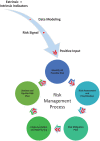Identifying Nontraditional Epidemic Disease Risk Factors Associated with Major Health Events from World Health Organization and World Bank Open Data
- PMID: 34460422
- PMCID: PMC8592146
- DOI: 10.4269/ajtmh.20-1318
Identifying Nontraditional Epidemic Disease Risk Factors Associated with Major Health Events from World Health Organization and World Bank Open Data
Abstract
Health events emerge from host, community, environment, and pathogen factors-forecasting epidemics is a complex task. We describe an exploratory analysis to identify economic risk factors that could aid epidemic risk assessment. A line list was constructed using the World Health Organization Disease Outbreak News (2016-2018) and economic indicators from the World Bank. Poisson regression employing forward imputations was used to establish relationships with the frequency with which countries reported public health events. Economic indicators demonstrated strong performance appropriate for further assessment in surveillance programming. In our analysis, three economic indicators were significantly associated to event reporting: how much the country's urban population changed, its average forest area, and a novel economic indicator we developed that assessed how much the gross domestic product changed per capita. Other economic indicators performed less well: changes in total, female, urban, and rural population sizes; population density; net migration; change in per cent forest area; total forest area; and another novel indicator, change in percent of trade as a fraction of the total economy. We then undertook a further analysis of the start of the current COVID-19 pandemic that revealed similar associations, but confounding by global disease burden is likely. Continued development of forecasting approaches capturing information relevant to whole-of-society factors (e.g., economic factors as assessed in our study) could improve the risk management process through earlier hazard identification and inform strategic decision processes in multisectoral strategies to preventing, detecting, and responding to pandemic-threat events.
Figures



References
-
- World Health Organization , 2008. International Health Regulations (2005). 2nd edition. Geneva, Switzerland: WHO.
-
- World Bank Group , 2019. World Bank Open Data. Available at: https://data.worldbank.org/. Accessed 2019.
MeSH terms
LinkOut - more resources
Full Text Sources

